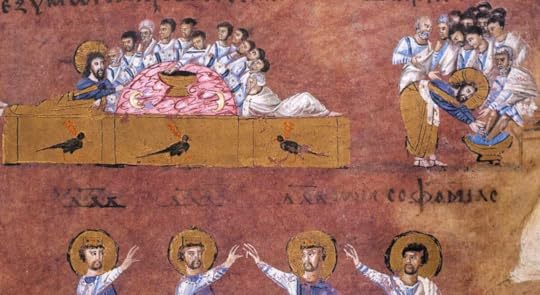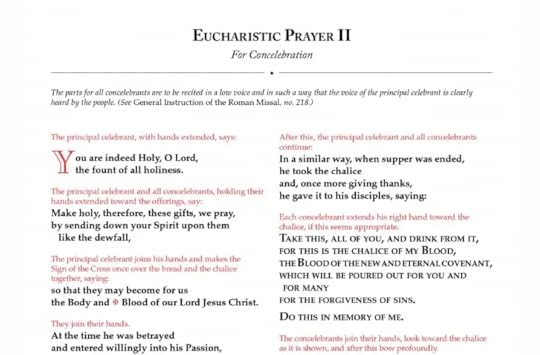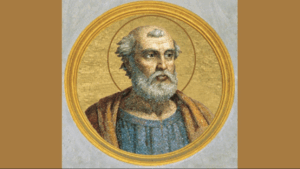Taylor R. Marshall's Blog
September 9, 2025
1250: Is Your Friend Possessed? Spiritual Warfare Q&A – Jesse Romero and Dr Dan Schneider
How do you know if someone is possessed by a devil? How do people become possessed by demons? Join us for Spiritual Warfare Q&A with Jesse Romero and Dr. Dan Schneider, authors of the new book: Spiritual Warfare Q&A: https://tanbooks.com/products/books/s…
Taylor Marshall’s new bestselling book: Christian Patriot https://amzn.to/4nk3fAj order here
Watch this new podcast episode by CLICKING HERE
The post 1250: Is Your Friend Possessed? Spiritual Warfare Q&A – Jesse Romero and Dr Dan Schneider appeared first on Taylor Marshall.
September 5, 2025
1249: 12 Strategies to Restore Christian Civilization – Dr. Taylor Marshall
Get your copy of Christian Patriot (4 link options):
Order on Amazon https://amzn.to/4oZPXuJ Order on Bookshop.com (currently discounted):
https://bookshop.org/p/books/christia…
Order on Barnes and Noble: https://www.barnesandnoble.com/w/chri…
Signed and Numbered Books by Taylor & Super Bowl Champ Harrison Butker https://ChristianPatriotBook.com
Watch this new podcast episode by CLICKING HERE
The post 1249: 12 Strategies to Restore Christian Civilization – Dr. Taylor Marshall appeared first on Taylor Marshall.
September 4, 2025
1248: Pope Leo Meets with Israel President: What do Pope Pics Mean?
Pope Leo XIV met today with the President of Israel—lots of discussion about the photos. Even more debate on photos with Fr James Martin SJ. Dr. Taylor Marshall discusses.
Get your copy of Christian Patriot (4 link options):
Order on Amazon (14% price drop today) https://amzn.to/4oZPXuJ Order on Bookshop.com (currently discounted):
https://bookshop.org/p/books/christia…
Order on Barnes and Noble: https://www.barnesandnoble.com/w/chri…
Signed and Numbered Books by Taylor & Super Bowl Champ Harrison Butker https://ChristianPatriotBook.com
Watch this new podcast episode by CLICKING HERE
The post 1248: Pope Leo Meets with Israel President: What do Pope Pics Mean? appeared first on Taylor Marshall.
September 2, 2025
1247: Did Pope Leo Just Endorse Fr. James Martin? 😥 Dr. Taylor Marshall laments
Just after the horrific tragedy last week, Pope Leo met with and took a photo with Father James Martin, SJ, who is the Catholic priest advocate for #1 L-G B T in the USA. Is this the end of the “wait and see” period for Pope Leo? Taylor Marshall laments.
Watch this new podcast episode by CLICKING HERE
The post 1247: Did Pope Leo Just Endorse Fr. James Martin? 😥 Dr. Taylor Marshall laments appeared first on Taylor Marshall.
August 29, 2025
1246: Christian Nation or Demonic Nation? Michael Matt and Dr. Taylor Marshall
You have to choose the future for America. Is it a Christian Nation or a Demonic Nation? There is no neutral ground. Dr. Taylor Marshall and Michael Matt discuss.
Watch this new podcast episode by CLICKING HERE
The post 1246: Christian Nation or Demonic Nation? Michael Matt and Dr. Taylor Marshall appeared first on Taylor Marshall.
August 27, 2025
1245: Tragedy at Catholic School: Pope Leo sends message – Dr. Taylor Marshall
The perpetrator of Wednesday morning’s tragedy at a Catholic School reveals a hostile war against Christianity. Dr. Taylor Marshall comments.
Watch this new podcast episode by CLICKING HERE
The post 1245: Tragedy at Catholic School: Pope Leo sends message – Dr. Taylor Marshall appeared first on Taylor Marshall.
August 26, 2025
1244: Catholic and Orthodox Clergy defy Israeli Evacuation
The Latin Catholic Patriarchate of Jerusalem and the Greek Orthodox Patriarchate have issued a joint press release confirming that priests and nuns will not evacuate and will stay to care for the Christians in Gaza, risking their lives.
Watch this new podcast episode by CLICKING HERE
The post 1244: Catholic and Orthodox Clergy defy Israeli Evacuation appeared first on Taylor Marshall.
August 25, 2025
1243: Cardinal Burke says Youth are Flocking to Latin Mass, laments changes after Vatican II
His Eminence Cardinal Raymond Burke explained why the Traditional Latin Mass “is attracting the young people and which attracts me is that the form of the rite is such that it makes it clear that it’s Christ Who’s acting.” Cardinal Burke noted that ancient Mass and Gregorian chant have been lost: “Well, those things somehow got lost. Not everywhere, but, sadly, in great part.”
Watch this new podcast episode by CLICKING HERE
The post 1243: Cardinal Burke says Youth are Flocking to Latin Mass, laments changes after Vatican II appeared first on Taylor Marshall.
August 24, 2025
Eucharistic Prayer 2 is NOT the Prayer of Hippolytus
The Anaphora of Hippolytus, which some claim is the basis for Eucharistic Prayer II in the Roman Missal, comes from the early 3rd-century text known as the Apostolic Tradition, traditionally attributed to Hippolytus of Rome, a presbyter and antipope (ca. 170–235 AD). Although its authorship and exact date are still debated, the text is an important witness to early Christian liturgical practice.

The source for this Anaphora is The Apostolic Tradition (or Egyptian Church Order), which was rediscovered in the 19th century and given the name of “Egyptian Church Order”. In the first half of the 20th century, this text was commonly identified with the lost Apostolic Tradition presumed to have been written by Hippolytus of Rome. Due to this assumption, and the apparent early date of the text, Apostolic Tradition played a crucial role in the liturgical reform of the Liturgical Movement and the Second Vatican Council, where it was commonly believed to be the ancient Roman liturgy and authored by Hippolytus of Rome.
In 1906, Eduard von der Goltz was the first to propose that the anonymous manuscript found in the 19th century was the Apostolic Tradition, which has been historically linked to Hippolytus of Rome. If the Apostolic Tradition is the work of Hippolytus of Rome, it would be dated before AD 235 (the year of Hippolytus’s martyrdom), and would have a Roman origin, which is Rome (Brent and Stewart). Opposing this view, Paul Bradshaw argued that the liturgical text was a patchwork from different sources, some Roman and some not, dating from the mid-second to the fourth century and redacted around 375-400 in Egypt or Syria. Lawrence Johnson suggests that the text of the Apostolic Tradition describes a liturgy that was never actually celebrated.
Liturgical scholar Dom Gregory Dix focused on the Anaphora of “Hippolytus” in his research for his 1945 book The Shape of the Liturgy. This book led to the common belief that this Eucharistic prayer represented the ancient Roman Eucharistic Prayer before the development of the Roman Canon in the fourth century. Even if it was the Eucharistic Prayer of Hippolytus, it may represent a schismatic Eucharistic prayer, since Hippolytus was an antipope at odds with several valid popes. It is quite a stretch to say that the Anaphora of “Hippolytus” is actually that of the historical Hippolytus. And even if it were, it may not represent the primordial Roman liturgy of the Catholic Church.
Eucharistic Prayer II and the Napkin StoryEucharistic Prayer II, although supposedly based on Hippolytus’s text, includes additions like the “dewfall” imagery from later Latin traditions and modifications to conform to modernized liturgical standards. Archives from the Consilium show Eucharistic Prayer II was drafted and revised over several months, with input from experts such as Cipriano Vagaggini and Louis Bouyer.

The “napkin story” about Eucharistic Prayer II being written on a napkin in a Roman tavern comes from an anecdote in the memoirs of Fr. Louis Bouyer, a French theologian and liturgist involved in the post-Vatican II liturgical reforms. The specific source is Bouyer’s Mémoires, published after his death in 2014 by Éditions du Cerf.
Bouyer, Louis. Mémoires. Paris: Éditions du Cerf, 2014, pp. 96–97.
In it, Bouyer recalls that he and Dom Bernard Botte, a Benedictine liturgist, finalized revisions to Eucharistic Prayer II during a late-night meeting at a trattoria in Trastevere, Rome, under pressure to deliver a corrected draft by the next morning. The story is often exaggerated to suggest the entire prayer was written on a napkin, but Bouyer’s account indicates they were refining an existing draft, not creating it from scratch.
Pope Paul VI and Eucharistic Prayer IIPope Paul VI approved Eucharistic Prayer II in May 1968. Afterwards, Pope Paul VI told Bouyer that he was not fully satisfied with the texts, saying, “Why did you all get mired in this reform?” Bouyer replied, “Because Bugnini kept assuring us that you absolutely wanted it.” Pope Paul VI responded, “But how is this possible? He told me that you were all unanimous in approving it.”
Bouyer, Louis. Mémoires. Paris: Éditions du Cerf, 2014, p. 97. An English translation of this passage is referenced in secondary sources, such as a 2014 article by Sandro Magister on his blog Chiesa (republished by Rorate Caeli on October 23, 2014). See “Original Sins: Eucharistic Prayer II – composed in a few hours in a Roman Trattoria.” Rorate Caeli, September 16, 2014. https://rorate-caeli.blogspot.com/201....
This side-by-side comparison reveals that while Eucharistic Prayer II draws language from the Anaphora of Hippolytus, it is not identical to that prayer. The table below indicates that Eucharistic Prayer II accounts for less than 20% of the Anaphora of Hippolytus. The claim that Eucharistic Prayer II is the Anaphora of Hippolytus is highly misleading.
Side-by-Side ComparisonThe red text denotes verbiage shared by neither prayer. The bold text denotes verbiage that is shared by both prayers.
Note from Taylor. It almost impossible to format the table showing the side-by-side in html here on the site, so I have included a link to the PDF, which was easier to format: Side-by-side comparison showing that Eucharistic Prayer II is NOT the Anaphora of Hippolytus (click to download).
You do not need to be a scholar to see that the two prayers barely align. There is only about a 20% match in words and concepts. Eucharistic Prayer II is an entirely modern prayer that uses the reputation of the so-called Anaphora of Hippolytus to give the appearance of antiquity and authority. It is a contemporary innovation. While it may not have been written in toto on the back of a napkin, it does not represent the ancient Roman liturgy.
Ferrari AnalogyImagine finding the ruins of an old car in a car scrap heap. Two experts say, “This car could very well be the famous 1963 Ferrari 250 GTO!”

Meanwhile, various experts cannot agree whether the discovered car is definitely a 1963 Ferrari 250 GTO. Dom Gregory Dix then writes an extremely popular book, Old Classic Ferraris, in which he claims that the discovered car is definitely the ultra-rare 1963 Ferrari 250 GTO, and this leads all automotive experts to study the scrap heap car. Then everyone bases all their knowledge of Ferraris on this now famous car found in the scrap heap.
They then announce the unveiling of the 1963 Ferrari 250 GTO to the public! To create this car, they take a mere 20% of the parts and styling from the junk heap car (of questionable origin) and the remaining 80% of the needed parts from modern race cars. Voila! They then enshrine the new creation and place a plaque saying, “Behold, this is the original 1963 Ferrari 250 GTO.”
This is Eucharistic Prayer 2. A manuscript of unknown origin was discovered. It was attributed to St Hippolytus (an antipope) as the ancient Roman Eucharistic Prayer. Then 20% of that prayer was used to create an entirely new prayer and published in 1970 with the reputation of being “The Eucharistic Prayer of Hippolytus.”
The folly is manifest.
ad Jesum per Mariam,
Taylor R. Marshall
PS: Use the Roman Canon!
The post Eucharistic Prayer 2 is NOT the Prayer of Hippolytus appeared first on Taylor Marshall.
Did Pope Gelasius deny transubstantiation? Nature and Substance Debate
Protestant theologians, especially Anglican ones, attempt to refute the Catholic doctrine of Eucharistic transubstantiation by citing a quote from Pope Gelasius. When I was an Anglican seminarian at Nashotah House, we were explicitly instructed to use this key Gelasian passage to oppose Catholics who insist on transubstantiation. It is a particularly bold tactic because Saint Gelasius is not just a Church Father, but also a Roman Pope from AD 492-496.

The passage is from Pope Saint Gelasius’ work De duabus naturis in Christo Adv. Eutychen et Nestorium (On the two natures of Christ against Eutyches and Nestorius) at section 14. I have included the original Latin text:
1. That this mystery began from the origin of the blessed conception, Sacred Scripture testifies, saying: “Wisdom built for herself a house” (Prov. 9:1). Supported by the solidity of the sevenfold Spirit, it refers to the Incarnation of Christ, through which we are made partakers of the divine nature and receive nourishment.2. Certainly, the sacrament which we receive, the body and blood of Christ, is a divine thing; and yet the substance or nature of bread and wine does not cease.
3. And certainly, the image and similitude of the body and blood of Christ is celebrated in the action of the mysteries.
4. Therefore, it is evidently shown to us that we must hold this in Christ the Lord Himself, that in His image we profess, celebrate, and receive.
5. That just as they pass into this, namely into the divine substance, the Holy Spirit perfecting, nevertheless remaining in the propriety of its nature.
6. So that the principal mystery itself, whose virtue and efficacy they truly represent,
7. From which permanent things the one Christ, properly remains constant, because the integrity and truth are shown to remain.
1. Quod mysterium a beatae conceptionis exordio sic coepisse sacra scriptura testatur dicendo: Sapientia aedificavit sibi domum, septiformis Spiritus soliditate subnixam, quae incarnationis Christi, per quam efficimur divinae consortes naturae, ministraret alimoniam.2. Certe sacramenta, quae sumimus, corporis et sanguinis Christi divina res est, et tamen non desinit substantia vel natura panis et vini.
3. Et certe imago et similitudo corporis et sanguinis Christi in actione mysteriorum celebrantur.
4. Satis ergo nobis evidenter ostenditur hoc nobis in ipso Christo Domino sentiendum, quod in ejus imagine profitemur, celebramus et sumimus:
5. *ut sicut in hanc, scilicet in divinam, transeant sancto Spiritu perficiente, substantiam permanentes tamen in suae proprietate naturae;
6. sic illud ipsum mysterium principale, cujus nobis efficientiam virtutemque veraciter repraesentant,
7. ex quibus constat proprie permanentibus, unum Christum, quia integrum verumque, permanere demonstrant.
*There is an alternative reading provided by Schwartz for verse 5:
Standard reading ut sicut in hanc, scilicet in divinam transeant
Schwartz reading: ut sicut haec licet in divinam transeant
The difference doesn’t substantially change the meaning of the text. The primary difference being:
Haec is nominative
Hanc is accusuative
The important text is verse 2, where Saint Gelasius explicitly states, “yet the substance or nature of bread and wine (substantia vel natura panis et vini) does not cease.” Strictly speaking, this would place Saint Gelasius at odds with the dogmatic definition of the Council of Trent on transubstantiation, which reads as follows:
“If anyone says that in the sacred and holy sacrament of the Eucharist the substance of the bread and wine remains conjointly with the body and blood of our Lord Jesus Christ, and denies that wonderful and singular change of the whole substance of the bread into the body and the whole substance of the wine into the blood, the appearances only of bread and wine remaining, which change the Catholic Church most aptly calls transubstantiation, let him be anathema.” (Council of Trent, Session 13, Canon 2).”
Trent rejects the affirmation that the substances of bread and wine remain after the consecration. Gelasius says “the substance or nature of bread and wine (substantia vel natura panis et vini) does not cease.”
Two Possible ResponsesThe Catholic is faced with two possible responses to the formulation of Pope Gelasius:
Gelasius was wrong and held an incorrect belief about the Eucharist. But it doesn’t matter because Popes can be personally mistaken on matters of doctrine before their dogmatization.Gelasius used “substance or nature” analogically to refer to what later Catholics called the “accidents of bread and wine,” and verses 5 and 7 reveal his clarification on that matter as in conformity with later Catholic teaching.The proper response is that the second option, that Gelasius clarified his meaning in verses 2, 5, and 7. Let us look at the passages:
In verse 2, Gelasius states:“the sacrament which we receive, the body and blood of Christ, is a divine thing (divina res).”
The Latin “res” refers to what is real. Our English word “real” comes from res. It is a divina res, or divine reality. Only after stating this does Gelasius say that “the substance or nature of bread and wine do not cease.” This is problematic because res usually refers to substance. However, we find clarification in verses 5 and 7.
In verse 5, Gelasius states:5) That just as they pass into this, namely into the divine substance, the Holy Spirit perfecting, nevertheless remaining in the propriety of its nature.
Gelasius states in verse 5 that the bread and wine transeant (pass into or transition into) the divine substance. I have never heard a Protestant affirm that the bread and wine transition into the divine substance. Gelasius then affirms “nevertheless remaining in the propriety of its nature.” The bread and wine here retain not their “natures,” but he clarifies that they retain what is “propriety of its nature.” Gelasius refers here to what is proper to the nature of bread and wine, but this time does not denote “nature” simply. He is clarifying his statement in verse 2. What is proper to the nature of bread? Texture, smell, taste, etc. These are what would later be separated as the “accidents” or sensible features pertaining to the substance of bread. But the res is divine. This essentially clears up the misunderstanding.
Moving to verse 7:From which permanent things, the one Christ, properly, remains constant, because the integrity and truth are shown to remain.
Gelasius here indicates that the one Christ is constant or enduring in the Eucharist. The full presence of Christ is in the Eucharist.
Two Possible PositionsFrom this analysis, Gelasius could be said to hold either of the two positions:
Consubstantiation: The substances of bread and wine are united to Christ’s divine and human substances. This is problematic because it creates a second hypostatic union with bread and wine. So that Christ now has a divine substance, a human substance, a bread substance, and a wine substance. Actually, it would create a second hypostatic union (union with bread substance) and then a third hypostatic union (with wine substance), since the consecration of each species is separate from the other.Transubstantiation: The substances bread and wine are transubstantiated into the substances of Christ’s divine substance and human substance—the position of the Fourth Lateran Council and the Council of Trent.One could argue that Gelasius affirms consubstantiation, but he is undoubtedly not affirming a symbolic or memorialist Eucharist held by most Protestants. I think the strongest argument is that Gelasius is describing transubstantiation, because he describes the bread and wine “remaining in the propriety of its nature.” He clarifies “nature” as actually being what is “proper to its nature.”
Furthermore, Gelasius was pope from 492 to his death on 21 November 496. He was daily praying the Roman liturgy with the fully developed Roman Canon as the Eucharistic anaphora or prayer. It is difficult to read the Roman Canon with its prayers over the Eucharist and deduce anything less than transubstantiation. Even Martin Luther (who held something closer to consubstantiation) felt the need to reject the Roman Canon (as used by Gelasius in the fifth century) because of its “transubstantiation” theology.
Imprecision is not HeresyIn conclusion, Gelasius affirmed the real presence of Christ in the Eucharist and asserts that it enters into the divine substance. He remarks that the substance or nature of bread and wine does not cease, but just after that, he clarifies his meaning by his reference to what is proper to their nature.
This debate is akin to that of the miaphysite arguments after the Council of Chalcedon. Miaphysite teaching is based on Saint Cyril of Alexandria’s formula μία φύσις τοῦ θεοῦ λόγου σεσαρκωμένη, meaning “one physis of the Word of God made flesh.” Chalcedon declared “two natures” in Christ but never doubted Saint Cyril’s orthodoxy or sanctity. Saint Cyril defended the right concept but used a different (misleading) formulation regarding one physis or nature with respect to the incarnation. Nobody doubts that Saint Cyril was correct, but later Catholic teaching rejects the “one nature” formulation of Saint Cyril in favor of “two natures.”
Gelasius is teaching the Catholic (Tridentine) doctrine of the Eucharist, but with the confusion about “substance or nature” not being what later Catholic dogma would articulate. Nevertheless, Gelasius does clarify in verse 5 that he is speaking of that which is proper to the nature of bread and wine.
ConclusionPope Gelasius (pope from 492-496) would be in continuity with his papal predecessor Pope Leo the Great (pope from 440 to 461) who wrote:
“Dearly beloved, utter this confession with all your heart and reject the wicked lies of heretics, that any contagion with error may not pollute your fasting and almsgiving: for then is our offering of the sacrifice clean and our gifts of mercy holy, when those who perform them understand that which they do. For when the Lord says, “unless ye have eaten the flesh of the Son of Man, and drunk His blood, ye will not have life in you,’ you ought so to be partakers at the Holy Table, as to have no doubt whatever concerning the reality of Christ’s Body and Blood. For that is taken in the mouth which is believed in faith, and it is vain for them to respond ‘Amen’ who dispute that which is taken.” Pope Saint Leo the Great, Sermon 91:3
The worst-case scenario is that Gelasius was teaching consubstantiation (not Protestant symbolism), but this is unlikely. The context of the passage seems to indicate that the bread and wine “enter into the divine substance,” but the properties of bread and wine remain. The entire context suggests what later theologians would call “transubstantiation,” even if Gelasius’s formulation is awkward. The goal here is to use the Eucharist as an analogy in discussing Christology, not as a dogmatic statement about the metaphysics of the Eucharist. That’s why the passage isn’t a major issue for Catholic theologians.
The post Did Pope Gelasius deny transubstantiation? Nature and Substance Debate appeared first on Taylor Marshall.



